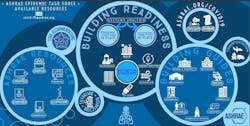ASHRAE Publishes New Position Document on Infectious Aerosols
On October 13, ASHRAE published a new 27-page Position Document on Infectious Aerosols. It is informed by the work of the pandemic-driven Epidemic Task Force (ETF), which formally disbanded in June, as well as the Environmental Health Committee (EHC), which remains in operation. Former ASHRAE President William Bahnfleth, PE, PhD, served as ETF chair and is now vice chair of EHC. He pointed us to this new document (PD) as our guest on the November episode of our monthly podcast, HPAC On The Air.
To hear that full discussion, please click here.
__________
From the Position Document introduction...
The magnitude of risk from aerosolized pathogens has become increasingly obvious, especially during the COVID crisis. These risks are particularly elevated in enclosed buildings. Public-health officials, policymakers, building owners, designers, and members of the public all need accurate, reliable guidance for appropriate ways to mitigate the risk from these pathogens. Available risk mitigation strategies include pharmaceutical interventions, non-engineering controls, and engineering controls. Given the concurrent climate crisis, the optimal mitigation bundle of interventions must achieve the highest possible risk reduction with the lowest possible resultant emissions...
Why ASHRAE Takes Positions on Infectious Aerosols
ASHRAE consensus standards and design guides provide the technical foundation for international building practices and energy codes that balance the need for energy efficiency with the need to keep the indoor environment healthy and comfortable for occupants. The design, installation, and operation of buildings’ mechanical systems can improve—or impede—the buildings’ ability to mitigate risk from infectious aerosols. Consequently, ASHRAE’s positions, standards, and design guidance can help avoid health risks associated with infectious aerosols.
__________
ASHRAE Takes the Positions that:
- Exposure to infectious aerosols is an important factor in the transmission of infections in indoor environments between a source and a susceptible individual;
- Engineering controls demonstrated to reduce the risk of exposure to infectious aerosols include dilution with outdoor air provided by mechanical or natural ventilation, filtration of indoor air, indoor airflow patterns, and disinfection by germicidal ultraviolet light and other technologies proven to be effective and safe;
- Strategies using engineering controls for managing the risk from infectious aerosols should focus on reducing exposure to infectious aerosols in the breathing zone;
- Effective design, installation, maintenance, and operation of ventilation controls are critical to achieving needed risk mitigation. • Existing evidence for the effects of temperature and humidity on infection risk does not justify changes to ventilation and IAQ standards, regulations, and guidelines at this time;
- The effectiveness of any one risk mitigation strategy depends on many factors. Using multiple risk mitigation strategies will usually be more effective than reliance on any single strategy;
- Risk mitigation measures should be adaptable to levels of risk in a particular space;
- Combinations of engineering controls and non-engineering controls can be optimized for effectiveness, cost, and energy use.
__________
ASHRAE Recommends that:
A multidisciplinary research & development (R&D) working group be established, aiming to improve coordination between engineers, scientists, and health professionals and prioritize and accelerate the research agenda, development process, and dissemination. As a minimum, this research should include the following topics:
- Controlled intervention studies to quantify the impact on infection transmission resulting from various engineering controls considered singly and in combination with other nonengineering controls with respect to infectious aerosols of varying characteristics;
- Real-time detection methodologies for the purpose of improved variable control of HVAC controls responsive to different levels of risk;
- Methods to reduce the life-cycle cost and carbon emissions of engineering controls in all conditions;
- Studies to characterize the size-resolved emission rate of infectious aerosols for different pathogens and different respiratory activities and metabolic intensities, determine the relationship between size and risk of transmission, and predict the fate and transport of these aerosol particles in indoor environments;
- Quantitative infection risk evaluation tools for infectious aerosols (quantitative microbial risk assessment is widely used for water and food, but much less for aerosols);
- Impact of indoor airflow patterns on the transmission of infectious aerosols and the resulting risk of infection.
__________
ASHRAE Commits to:
- Support model codes and standards that address exposure to infectious aerosols, balancing quality of evidence, risk mitigation, cost of installation and operation, and energy use and carbon emissions;
- Support model codes and standards using variable amounts of outdoor/clean air delivery in response to the measurement of air quality to optimize indoor air quality in an efficient way;
- Promote research to enhance HVAC technologies and knowledge to mitigate the risk of infection due to airborne transmission.
__________
From Appendix B
The position document attempts to bridge the world of evidence-based medicine (EBM) and the imperative to use available evidence to make needed recommendations in the practical world of application of ventilation systems. Historically, the world of the application of ventilation systems has not had the kinds of investments in the research necessary to reach the levels demanded by the rigors of EBM. However, decisions must be made based on the best available evidence. Bringing these worlds together brings a level of transparency and rigor to the practical need for guidance to policymakers while also representing a call for further research to provide us with better data in the future.
The chart below offers just some of the guidance contained in the PD. For the rest, readers are encouraged to download it here.
##########

